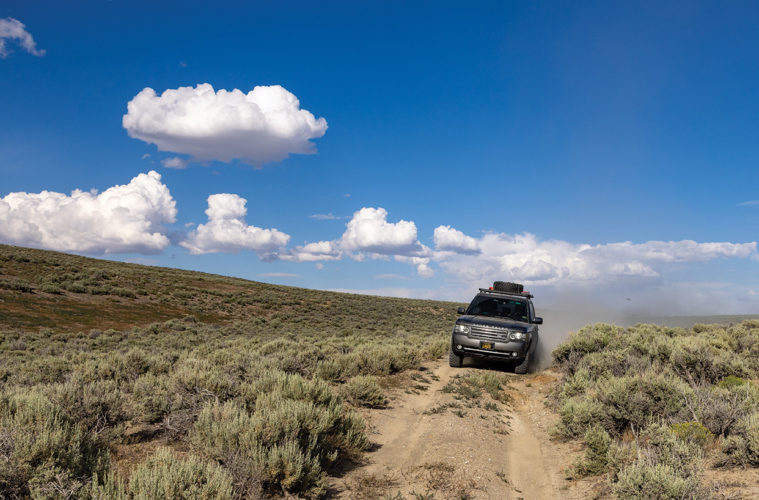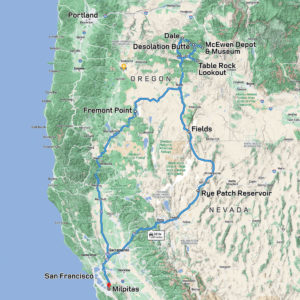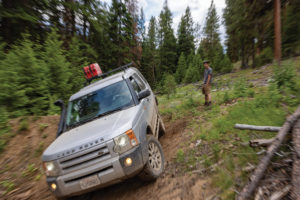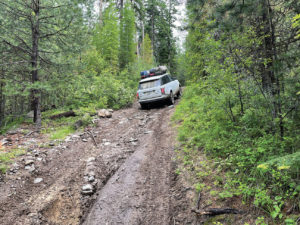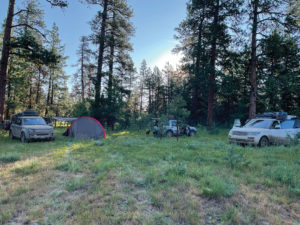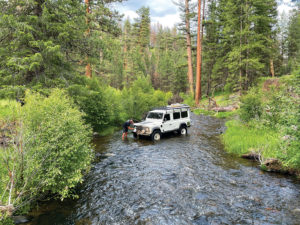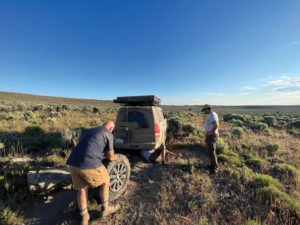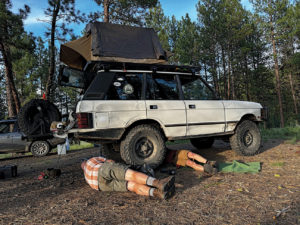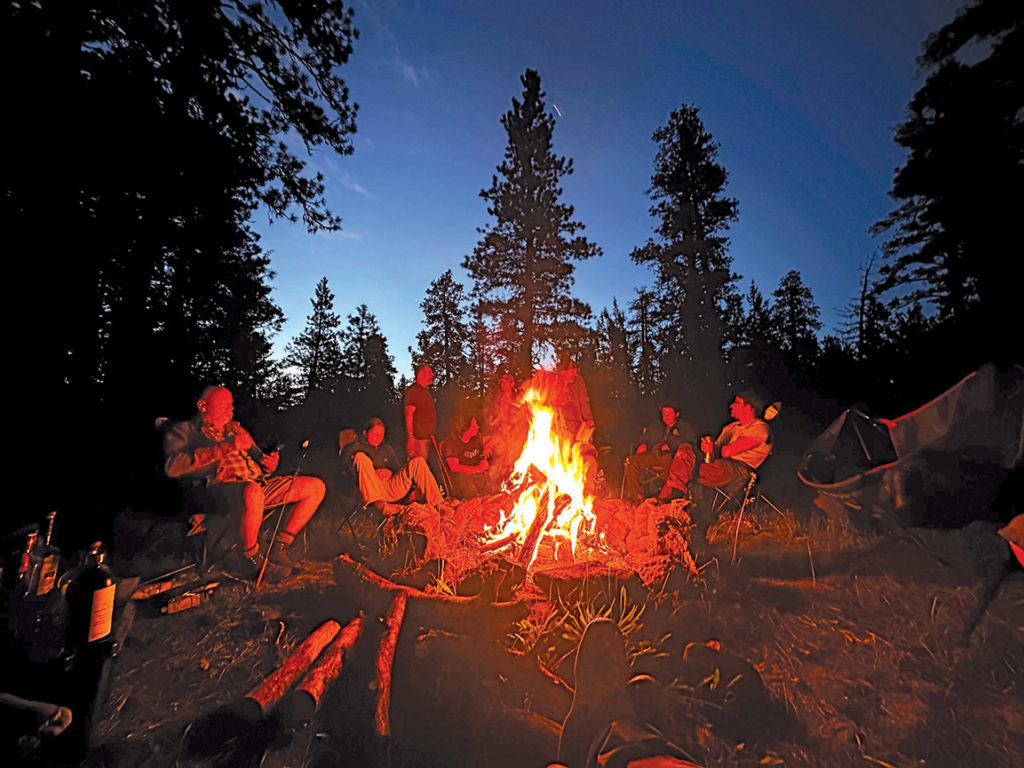California ranks third in terms of US land mass, behind only Alaska and Texas. Our 163,696 square miles normally provide enough area for the Northern California Land Rover Club (NCLR) events, but we added an annual overlanding event to our calendar — so we needed a bit more wild space.
Although nearly 700 miles away from our base region, Oregon’s Backcountry Discovery Route #5 lured us to the state’s high desert region. This past June, our group of 11 vehicles enjoyed a 9-day trek through a stunning landscape — the experience felt well worth the mileage and fuel bills! (Thanks to the Oregon Off-Highway Vehicle Association [OHVA] for promoting these routes.)
The Overlanders:
- We formed an intrepid collection of explorers spanning an impressive range of generations, both in terms of participants and Land Rover models:
- Sasha Sher, Scotts Valley, CA, ’05 LR3
- Mike and Leigh Anne Foster, Reno, NV, ’91 Land Rover 110
- Johann Krueger, Los Gatos, CA, ’07 LR3
- Jeff Brown, Los Altos, CA, ’14 Range Rover
- Cris and Sebastien Lau, San Jose, CA, ’97 NAS Defender 90 (Father and son)
- Robert and Jason Dingli, Cupertino, CA, ’04 Discovery II (Father and son)
- Mark, Oliver and Amelia Draffen, San Mateo, CA, ‘05 LR3 (Father and teenagers)
- Paul Liszewski, San Francisco, CA, ’10 Range Rover
- Will Seldon, Aptos, CA, ’19 Defender 110
- Nathan, Corinne, and Gryphon Harrison, Atascadero, CA, ’11 Range Rover
- Miles, Theresa, and Henry Wynn, Los Gatos, CA, ’90 Range Rover Classic (Father, mother and son)
Landscapes and Driving
Overlanding freed us to marvel at the vistas and scenery that we traversed and practice “no trace” camping. We drove north through California’s Kern County to our final fuel station in Rye Patch, NV. We entered our overland route in Dale, OR. Much of our travel was on gravel roads, some with wonderfully steep grades, some barely noticeable. As we entered Oregon, the surroundings changed from desert shrubs to high desert bushes, to cottonwoods and alfalfa-bearing soils, and later, to Ponderosa Pines and volcanic formations.
Once on the OHVA route, we aired down and enjoyed nature’s landscape and the emblems of civilization’s past eras. The Table Rock Lookout provided spectacular views due to its 7,815 ft elevation. We climbed to the Desolation Butte Lookout tower for a quick stop (67-ft high, 7,028 ft elevation), and surveyed the still-active Allison Guard station built in 1911. Another drive took us to the Fremont Powerhouse, a hydroelectric plant completed in 1906 to supply power to the nearby Red Boy mines and even closer town of Granite, OR. We visited the McEwen Depot & Museum Railyard and saw a steam engine up close.
The driving experiences tested our off-road abilities. For example, as we neared Sumpter, we began climbing an increasingly narrow trail behind Phillips Lake – my ’90 Range Rover Classic, “Snowflake,” scrambled right up and Paul’s L322 followed close behind. We spent some time getting everyone up the trail – the two major obstacles being a large V-notch and a massive boulder that required the newer models to climb up the bank and then quickly steer back down into the trail to avoid a tree. After that, the trail became a narrow, puddle-filled pinstripe track until we reached our camp at Phillips Lake.
Between weather and trail conditions on our extended route between Dale and Klamath Falls, OR, we encountered sand, gravel, volcanic “potato rock” and “sharp pointed obsidian” rock formations, narrow trails, challenging forest paths and boulders hidden by tall grasses. Sections that proved passable for the first few vehicles collapsed under the weight of multiple Land Rovers.
The Campsites
Extended overlanding enabled us to delight in a variety of campsites, a highlight to the end of each day.
Day 1: Nestled at the base of Nevada’s Kamma Range, we explored the placer mine ruins, and gazed over at the active and impressive Hyperion Mine.
Day 2: Near Silvies we proceeded through the massive development that has morphed from a ranch to the posh, 140,000-acre Silvies Valley Range Retreat and Links. We quickly determined that this resort was above our pay grade and we continued into Mt. Vernon, OR, and the Driftwood Campground along the North Jay River.
Day 3: After an interesting visit to the Fremont Power House, we settled in for the night at Phillips Lake.
Day 4: Climbing down from Table Mountain we ran into many a mud hole, allowing the adventurous (and those less so) to try on a new temporary paint job. Turns out most rovers look great in brown. Eventually, we made our way to the Crane Creek campground for a refreshing evening. While most folks elected to bathe or shower in the creek, Mike went ahead and bathed his 110. In the end, it was spotless.
Day 5: Overlanders know that the “best-laid plans of mice and men” often fail, and that became our mantra on this day.
We made good time down to our marked campsite – Cheatum Holler Camp. However, to our dismay, the mosquitos swarmed hungrily and we decided to proceed down our track to check out sites on Sugarloaf Mountain – thwarted again, this time by a locked gate. Will found a reference for Alder Creek Camp several miles away; a short drive later we found the intended route did not exist. Eagle-eyed Paul spotted a large fire pit in a meadow. A radio call went out, and the people rejoiced! Alas, the tall meadow grass hid many a boulder [See Field Repairs], but once traversed, the site proved a viable campground.
Day 6: Most of us camped in the Lost Forest near Christmas Valley Dunes, reaching our destination around 7:30 p.m. Due to fatigue and night travel (See Field Repairs), Robert and Jeff decamped at Black Ridge, no mean feat given the technical rock ledge at its summit.
Day 7: After a day of challenging terrain and more field repairs, we determined that we deserved more comfortable camping and hot showers. We found a perfect venue at the Lakeside RV park in Christmas Valley.
Day 8: At Mud Flats. Jason and Miles rebuilt the aging fire pit while the campers set up for the night. Everyone was hungry, so we cooked up everything! Tri-tip, fajitas, burgers, dogs, you name it, we had it. Cobbler was made for desert with Cris supplying the ice cream! Even young Henry got in on the food action eating ¾ of a can of fruit cocktail, half a hot dog, half a chicken burger, and lastly a bottle.
The Successful Field Repairs
Overlanding tests your ability to effect repairs without rapid access to replacement parts. It’s your ingenuity that will make it possible to complete your journey. Here are the field repairs we made so we could complete our nearly 1,800-mile trek.
Miles Wynn, ’90 Range Rover Classic. Early in the event, my Range Rover Classic started to develop a harsh, constant vibration. Robert helped to identify it as a rear driveshaft U-joint. Also, my transfer case sensor buzzed incessantly despite everything working correctly.
Once into camp, Robert, Mike, and I removed the rear driveshaft and attempted to replace the U-joint. Unfortunately, my Range Rover still had the original driveshaft with 1300-size U-joints. Mike had only 1310 size U-joints. Without options for replacement, we opted to red Loctite them into place and ping over the edge, gripping the cups.
Meanwhile, Nathan helped open up the dashboard and disconnect the wayward buzzer. This may have been the most important job; I had promised Theresa that I would fix this intermittent (now permanent) issue. (Thank you, Nathan, for sparing my life!)
Lastly, the airline from my manifold to my front locker solenoid gave way, requiring another field repair.
Nathan Harrison, ’11 Range Rover. Entering our campsite one night, Nathan boldly drove his Range Rover through tall grass that hid many a boulder. His transfer case subframe had a hard meet-and-greet with a large rock, leaving the subframe crushed and pressed into the front driveshaft. Robert’s Milwaukee grinder, accompanied by several expletives, extricated the subframe from the driveshaft, leaving a protection-compromised but drivable L322.
Will Seldon, ’19 Defender 110 (L663). Will required an exhaust repair when a hidden rock pushed his exhaust pipe against the rear driveshaft. He also discovered a snapped rear shock on his 110. Will and Nathan both chose to exit the trails to prevent further damage to their Land Rovers. The two vehicles and their passengers made the rest of the overland safely.
Jeff Brown, ’14 Range Rover. The air suspension compressor had overheated and the Range Rover refused to rise above its bump stops. Initially, we thought the compressor had been overworked, as it quickly cycled between off-road height and highway height. Leaving no Rover behind, Robert and Oliver waited with Jeff for the Range Rover to cool down.
The compressor’s problems slowed Jeff’s progress. Paul Lizsewski found a leak in the passenger-side front airbag from the upper mount location through the O-ring. Robert, Mike, and Paul quickly scrambled together a patch using O-rings, RTV silicone, and a flat washer off Mike’s tire carrier. The field patch would last only 20 minutes before giving up the ghost, but we knew how to MacGuyver the Range Rover.
Johann Krueger, ’07 LR3. Sharp, dense obsidian rocks punctured the sidewalls on Johann and Paul’s vehicles. Fortunately, we had tire patches and plug kits on hand.
Oliver Draffen, ’05 LR3. Oliver had a check engine light reporting a misfire on cylinder 1. Sasha and Oliver tried replacing the sparkplug and swapping a coil pack — no joy — but an application of Seafoam seemed to clear out the injector.
The Finale
Exhilarated by our off-road driving, scenic vistas, and challenging field repairs, fed and happy from our camping experiences and content that we had given the Oregon Backcountry Discovery Route our all, we exited Oregon in Klamath Falls, jumped onto I-5, and headed south toward our homes. The 2023 NCLR Annual Overland will remain etched in our memories.
